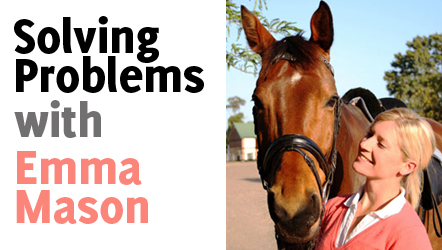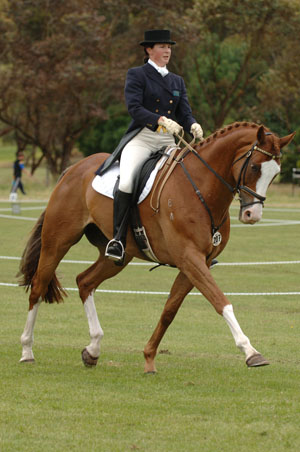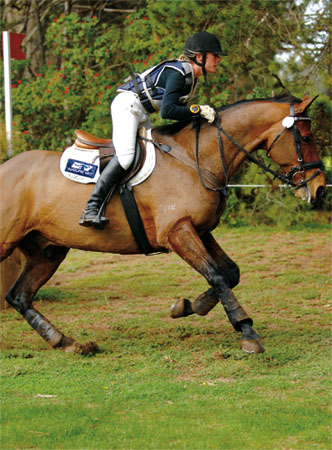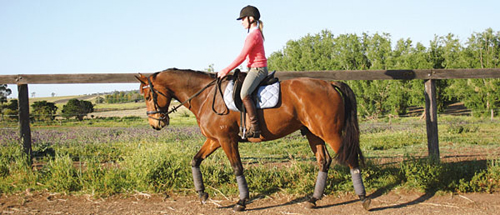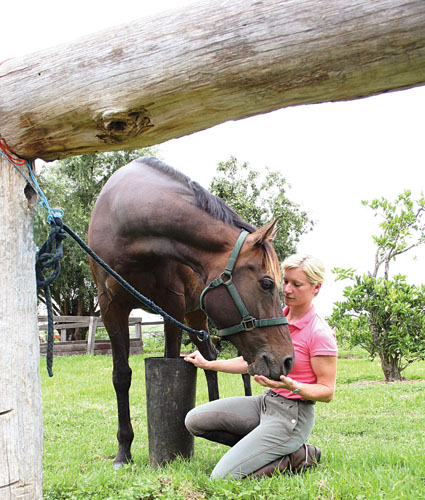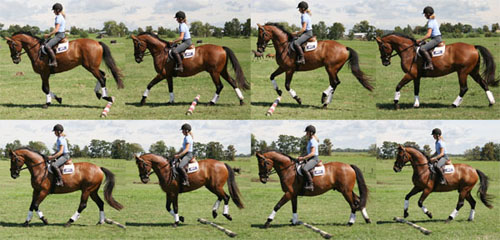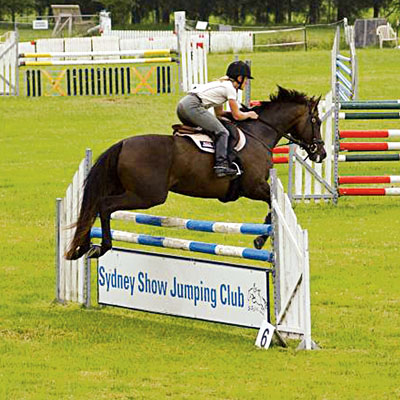When THM editor suggested that I write a “How to” series, providing eventing advice and tips for upcoming riders, my first thought was that I’m a bit under-qualified for the task – after all, I haven’t ridden at an Olympic Games like Rebel, or piloted countless horses to 3 and 4-star victories like Shane and Stuart. In fact, looking back through the years, (particularly as a junior, when I considered myself something of an equestrian connoisseur), I shudder at the mistakes I’ve made. Yet mistakes are an inescapable part of the sport, and the success of riders like Rebel, Shane and Stuart will not have been without the odd faux pas: Indeed, one of the keys to riding at the top level is learning from your (and others’) errors. Another crucial factor is experience: That is, sitting on a number of horses of varying ages, talents and temperaments, in a range of different situations. Considering the above, I decided that maybe I could offer some useful advice, after all (even if it’s sometimes in the form of ‘what not to do’).
My second concern was that these ‘instructional’ series’ have been done again and again, and I wondered what I could do to make my own articles worth reading, given the thousand that have been written before them. In light of the British and American basis of many of these publications, and the resulting ambits of advice that aren’t of much relevance to us, I thought I’d try to put a uniquely Australian ‘spin’ on some of the issues that are encountered in the sport of eventing. The first topic will be of particular interest to the many riders sitting on ex-racehorses (and anyone else on something a bit ‘fizzy’)…
#1 How to… get a quality dressage test out of a ‘hot’ horse
Does breaking into a jog in the walk movements sound familiar? How about halting for a grand total of 3 milliseconds before the fidgeting begins? Or trotting, tight-backed, around the arena with all the cadence of a sewing machine?
There is possibly nothing more frustrating than putting in countless hours of hard work, only to see it unravel before your eyes when you “Enter at A” on the day of the test. Whether the result of excitement, nerves, greenness, or even just being a bit fresh, an unsettled, ‘hot’ horse plus a dressage arena are a recipe for trouble.
But being partnered with such a horse needn’t condemn you to a lifetime of low scores and equally low spirits: There are many approaches that can be adopted both at home and at the competition to help coax a more settled, reliable test out of your fiery steed.
At Home
Performing a nice test on the hot horse begins well before the day of the competition. In many instances, the horse’s reactions stem from a lack of confidence or understanding, so in the weeks leading up to your event, practicing those elements of the test that tend to make him excited or antsy is of enormous value. Ideally, you’d like your horse to be so relaxed and confident in these movements at home, that even with the additional pressure and atmosphere of competition, he remains steady.
Unfortunately, because these often involve the walk and the halt, it can be about as thrilling as writing a school assignment, and takes a lot of time and patience. In my experience, the transition to medium walk at the end of the free walk is a common problem area: The horse just wants to ‘get the show on the road’ (bless him), and is not the slightest bit interested in showing nice, big, overtracking walk steps. When I’m schooling such a horse, I’ll practice free walk on a long rein across the diagonal, then pick up the reins and medium walk through the short side, or even for a circle, then let the reins out again across the next diagonal. I like to ride a hint of shoulder-in while I’m in medium walk, as I want the horse to be accustomed to my leg being on his side. This is particularly important when, at the higher levels, the free walk is followed by a walk-to-canter transition (the horse that isn’t accepting the rider’s leg is usually the one who explodes into canter with the subtlety of an atomic bomb).
Sometimes I’ll practice a halt or 2 when I’ve taken up the reins – I want him to gradually sort out in his mind that just because I’ve taken up a contact, doesn’t necessarily mean that a faster pace will follow. Some horses will respond quite quickly to the exercise, but I find that some others need to do it again…and again…and again. That’s where patience on your part is put to the test. When the horse is staying relaxed through the transition from free walk to medium walk, I’ll go back and ride the trot and canter, and then when he’s due for a bit of a breather, I’ll take the opportunity to practice the walk again.
The halt is another movement that is often the downfall of a fizzy horse, and the time to address the issue is at home, rather than in front of the judges. Once again, there are no magic tricks or shortcuts in teaching the horse to maintain the halt for the required 3, 4 or 5 seconds (if you are aware of any, please let me know). The hot horse often gives you the feeling of being so ‘on the edge’ in the halt that merely breathing will be enough to upset him. So, at home, I want to be able to halt and have those feet stay planted on the ground whilst I pat his neck, perhaps lean back and pat his rump, check the girth, adjust the stirrups and so on. Sometimes I’ll even send a short SMS or make a quick phone call that I’d forgotten to make earlier (“Hi Chris, it’s Em here…I promise we’ll have our Horse Mag column to you by tomorrow. No, really…”). It’s probably best that you leave the phone out of it, though.
When riding the transition, I try not to make too many adjustments, or nag too much, once the horse has stopped.
This not only has the tendency to worry some horses, but also contradicts the idea that we’d like him to stay immobile in the halt. If he isn’t square, I might ask him quietly to step one of his feet forward (always forward, never back!) in an attempt to square him, but I don’t want to make an issue of it. Be prepared to shrug your shoulders (and maybe mutter bugger or the like), and work on getting a better halt the next time. Like the walk exercise, this will need to be calmly repeated over and over before you’ll start to see any improvement.
There are also horses that, rather than becoming fired up over a particular movement, are just…well, a bit fired up on the whole. For these animals, walking out for, say, an hour each day (in addition to their normal workout) can be of huge benefit. It’s difficult to explain, in clear terms, exactly why taking your horse out walking has so much to offer. Certainly, the physical aspect can be readily understood – walking is a great way to loosen tight muscles and, at the end of a session, can reduce the likelihood of stiffness the following day. But also, it can be a means of relaxing the horse, without the fatigue element that accompanies a training session. I think there is something to be said about walking your horse (outside of the arena, in an environment that parallels walking about the paddock) that allows you to ‘connect’ with him, to gain his trust in you as a part of ‘his’ world. I wish I could express this idea a little less clumsily, but I think the psychological advantages of walking are significant. Take Nicole Uphoff and the famous Rembrandt:
The horse had no shortage of physical ability, but achieving the mental state required for a great dressage test was a struggle. So Nicole used to walk him – sometimes for 2 hours a day – as a means of addressing the problem. Ulla Salzgeber, too, used lengthy walk sessions to encourage Rusty to reach down and take the contact.
Indeed, even though the horse is on a relatively loose rein, we still want him to have his neck down, reaching for the bit. The obvious problem with this approach is the time factor – many people struggle to find enough hours in a day to fit in a schooling session, let alone a big walk, and when we’re talking more than one horse, the time really does get away. But if you can possibly manage it – not just the week before your test, but several weeks out – walking does seem to help the hot, tense horse.
At this point, I begin to worry I’ve given the impression that the hot horse requires a ‘calm’ or ‘quiet’ approach to training at home. This is true, to an extent, but probably more in terms of your own attitude and thoughts: As the rider, the challenge is to remain steady in your mind, not firing up or overreacting to the horse’s mistakes or, as it may be, misdemeanours. And believe me, that’s incredibly difficult to do on a horse that’s reaching boiling point! However, having the horse ‘tip-toe’ around the issues that come up will eventually end you in trouble: The competition environment will almost always create that bit of extra energy and spark in your horse, and if he’s completely unschooled at that level of power, the problems will inevitably arise. So at home, I want the horse to be confident working at higher levels of energy, so that the adrenalin of competition isn’t something completely foreign to him. His confidence is the key here, so it may be that I begin a session a little more conservatively, and as he relaxes, I’ll ask for a bit more pizzazz, a bit more oomph!
The days before the test
If I’m riding something a bit hot, I’ll avoid having him any fresher than necessary, as this is likely to exaggerate any problem areas. The day before the test, therefore, he’ll get a pretty big workout – maybe even twice. If I can possibly help it, I’ll let him spend that night in his paddock, rather than shut up in the stable, but sometimes after a bath this isn’t really a great option!
In the days leading up to the competition, some riders reduce the amount of hard feed, such as pellets and grain, and replace it with extra hay. This approach aims to reduce the horse’s level of energy, and settle him a little. It isn’t a method I’ve taken on board at this stage, because I’m concerned about the problems that can spring up on the side: Although it may produce a quieter dressage test, you run the risk of having a tired horse for the cross country and showjumping phase, and a tired horse is a horse that is likely to get injured. Also, sometimes it’s necessary to travel quite long distances in the float or truck to the competition, and horses will often lose weight on these journeys as it is, without decreasing their intake of food.
“Good as Gold” or similar ‘calming’ formulas such as Tranquil Paste are also available from produce and saddler stores. Again, this is an approach that I haven’t had a lot of experience with, but I know of many riders who speak favourably of such products. These often need to be given the day before, as well as on the day of the competition, so remember to plan ahead.
At the competition
You’ll hear this said time and again, but leave yourself PLENTY OF TIME to arrive at the competition, tack up the horse, find your arena and warm up. Being in a mad panic to ride your test at the allocated time will do nothing to help an already unsettled horse.
If I’m riding a young horse, I’ll give myself plenty of time to warm up, but much of that will be spent at the walk, just letting him relax and take in everything that’s going on without feeling like I’m in a hurry. For the more experienced horses, it can sometimes be a matter of experimenting to find out what sort of warm-up will produce the best test: A lot of walking is best for some, whilst others seem to need cantering for, well, ages before the tension starts to disappear.
I remember Rozzie Ryan telling me that the warm up routine that best suited her Grand Prix horse, Exellent, was to work him 2-3 times on the day of the test. These sessions weren’t particularly strenuous, but Rozzie found that the more times he came out, the more settled he’d become. The final warm up would consist of a normal session, and then 15 minutes or so before the test, she’d take him back to the float and let him have a bit of hay and basically ‘chill-out’. Then, just before her draw time, Rozzie would get back on, and pretty much go straight into the arena. The theory behind this approach is that some horses become more and more adrenalized, the longer they warm up, so that they’re close to bubbling over by the time of the test. Giving the horse the chance to chill out in the few minutes beforehand curtails this adrenalin somewhat, helping to keep him sane during the performance, and indeed Rozzie found this very effective for Exellent.
Another rider who is partnered with a very flash, very extravagant, but not very easy horse is Claudia Graham. Claudia has worked out an approach that allows Blazing Chief to perform at his best during those crucial minutes in the arena, and has the results to show it, winning this phase (and as it happens, the entire event) at both Camden ODE and Lakes and Craters 3DE, against a strong field. I spoke to Claudia about Chief’s program both leading up to the competition, and on the big day.
The challenge with Chief, Claud tells us, is not so much that he’s hot, but that his playfulness and enthusiasm can affect his focus in the test. There is also the risk that he’ll overreact to her aids if he’s not completely confident in the work. In response these issues, Claudia rides Chief twice daily in the week before the event, focussing on the horse’s confidence in performing each of the test movements. At the same time, the two workouts help to keep a lid on his bubbling energy. On the day of the competition, if her test is scheduled for midday or later, Claud will fit in another ride that morning.
Then there’s that crucial final warm-up, and Chief’s rider is very aware of getting the timing just right: The 10 minutes or so in front of the judges needs to reflect the horse at his peak. And while Chief’s amazing levels of energy can spill into naughtiness if the warm-up is too short, Claud is very careful not to overdo it, such that Chief’s ability to show off his athleticism and scope is limited as a result of him becoming tired. For Chief, the time spent in the final warm-up is still changing: Initially, it was up to an hour and a half, but as the horse becomes more experienced and more mature, the minutes are dropping off. These days, it is common that 45 minutes will see Chief burst into that arena and produce his best work.
Claudia’s approach to riding a test on Chief is a great illustration of the need to consider each horse individually, and to be prepared to experiment a little to see what works best: No two horses are the same, so what
works for one may not be effective for another!
Riding a good test on a horse that is a bit hot is not an easy task, and achieving it will come only through time, effort, patience and more likely than not, a bit of trial and error. But so important is a good dressage score to your final placing that it’s well worth the effort. Good luck!
How to make – not break – an eventing horse.
A fit, sound horse is critical in the sport of eventing, especially when it comes to the cross-country phase of a Three Day Event.
This month’s lesson will focus on managing the horse’s fitness and wellbeing throughout your preparation for a three day event, and in keeping with the Aussie flavour of the series, will pay particular attention to hard ground, hot weather and other uniquely Australian conditions!
The Fitness Program
Just like people, horses come in all shapes and sizes (and attitudes toward exercise!), so I try to work out a fitness regime that best suits each individual horse. The ex-racehorse seems to be blessed (cursed?) with a remarkable level of natural fitness (hence the problems we can sometimes run into in the dressage phase, as discussed last month!), and is usually quite happy travelling at faster speeds. For these reasons, the Thoroughbred may not need the same type or amount of work as, say, a Warmblood.
For example, leading up to Melbourne Three Day Event in 2007, I had two horses to prepare: Angelina Ballerina, a Thoroughbred mare in the 1-star class, and Farinelli, a Warmblood/TB gelding entered in the 2-star. The level at which they were competing was definitely a factor, as the 1-star horses aren’t required to travel as far, or as fast, as the higher grades. But I also had to consider the marked differences between them: Angelina is like, well, a ballerina – really athletic, nimble and quick on her feet. Galloping across country at the One Day Events leading up to Melbourne, plus schooling this phase at home, was enough to see her cruise around the Three Day course and barely raise a sweat. Farinelli, on the other hand, is naturally a bit heavier and not quite as fast, so it was necessary to begin his gallop work some 8 -10 weeks before the big event.
Additionally, the age of the horse should be considered – the older horse may take a little longer to ‘bounce back’ after a strenuous workout. Also of relevance is whether the horse has undertaken a 3DE preparation in the past, as this horse will often need less work to reach the desired level of fitness than one starting from scratch.
Gallop work?
The term ‘gallop’ is traditionally used for these fitness sessions, but for the most part, I’m really referring to more of an ‘open’ canter. I like to schedule a gallop session once every four days, and I try to make the day after a gallop a little less strenuous. For instance, I might work the horse on the flat, keeping my eye out for signs of fatigue or soreness, and then walk him in an attempt to ease any stiffness. I avoid jumping the day after a gallop session.
It is likely that you’ll be competing in One Day Events in the weeks leading up to a Three Day Event, so you may have to adjust your horse’s fitness program slightly to allow for the cross country phase of these events: Running the horse around the cross country is counted as a gallop session, and as this usually falls on a Sunday, you’d ideally like to gallop him about Wednesday of the week prior.
The actual content of the session really does depend on the individual horse, but as a general rule, I’ll walk for about 10 minutes and trot for five as a warm up, and then the actual workout is made up of three sets of gallop with a three minute walk in between. To warm down, I’ll trot for a few minutes and then walk until he’s stopped puffing and his breathing starts to return to normal. I try to use these gallops as an opportunity to get the horse soft and round at this pace, rather than letting him coast around like a llama: After all, a horse that is easily adjustable in front of the fences is much more likely to make the time allowed than the fast horse who fights his rider the whole way around.
If I’m riding a horse that copes well with the faster work, I might use these sessions for conditioning more than anything else. In this case, the set might be longer, perhaps eight minutes, but at a reasonably steady pace, and this has the advantage of putting less strain on the horse’s legs.
Until you’re used to it, riding in your 2-point, light seat for this amount of time will probably have your legs and back screaming in protest, but it’s important to keep up off your horse’s back! I’d then use cross country training sessions to school short bouts of the fast work, usually by having a gallop between fences and then working on having the horse listen and come back to me before the jump.
For horses like Farinelli, I want to introduce a faster pace into the gallop sets. I might begin this type of program with five minute sets, and increase the time gradually. We’re fortunate at Lochinvar to have a gallop track that incorporates a nice, steady climb up a gentle hill, and it is here that I’ll open the horse up to a gallop.
This has the benefit of accommodating the fast work, but with a little less strain on the forelegs (travelling at speed on a surface that slopes even slightly downward is risky, as it puts a lot of pressure on the horse’s front end). I usually don’t sprint the horse in the third set, as he will be growing quite tired, and again, the risk of injury increases.
The gallop surface
The surface upon which you gallop your horse can play a big part in keeping him sound, and in Australia, where we’re so often in need of rain, this can present difficulties. If the ground is hard where you ride, be prepared to travel him to a more suitable venue for his gallop work: The firm sand at the beach is ideal, as it provides just enough ‘give’, and is nice and level. Also, walking him in the shallow water is an excellent natural means of cooling and soothing his legs. Obviously, however, not everyone is lucky enough to have an ocean around the corner, and even then, many beaches do not permit horse riding (and have signs every couple of metres, making it difficult to pretend that you didn’t know!). It may be a matter of asking around – your coach or other riders will often know of a suitable place in your area.
Ice
To help lessen the potential damage to your horse’s legs that galloping on hard ground – indeed, galloping at all – can cause, it is recommended that you get into the habit of icing him. This is crucial following the cross country phase at an event, not only to prevent damage, but also to make him feel as comfortable as possible going into the showjumping.
There are a few different styles of ice boot available, but my favourite is the “Big Foot” boot, as it targets a huge area, from the hoof right up to above the knee. I fill them about 1/3 of the way up with water, then put the horse’s leg into the boot (making sure his foot is standing flat on the ground) and then slowly fill the rest with ice. The drawback with these is that unless you have a horse that’s virtually comatose, you’ll have to sit with him while he does his time in the boots.
Another style out there is the boot with several pockets on the inside which are filled with ice, then secured on the horse’s leg via Velcro tabs. The advantage of this boot is that you won’t have to constantly monitor the horse, although the boots will need to be tightened from time to time, as the ice melts.
At a Three Day Event in particular, the horse has travelled a greater distance and is required to be sound at the Horse Inspection the next morning, so you may have to apply ice on and off right up until the stables are closed (at about 11 pm) and then again when they re-open. That’s where a groom or a parent/friend can definitely come in handy!
Riders often differ in their opinions as to the time intervals at which ice should be applied following the cross country phase of a 3DE. I’ve come across some who prefer 20 minutes on / 20 minutes off, but others who will stand the horse in ice for 3 hours non-stop. I’ll usually put my protesting horse in the Big Foot boots for about 45 minutes, with a 15-20 minute break. The number of times I repeat this depends on whether he sustained any knocks or bumps whilst on course, or if there’s any obvious discomfort or signs of soreness. After a gallop session at home, 30 – 40 minutes in ice should minimise any damage, and if you can’t access ice, even letting the cool water from the hose trickle over his legs for a while will help.
The heat
While there’s a lot to love about Australian summers, the effect of the hot weather on your horse’s performance and recovery is a factor that needs your attention when embarking on a fitness program. Galloping a horse during the hotter months of the year is akin to us going for a run in the middle of the day in summer – we feel tired much more quickly, and it takes longer for our body to cool down (and for our face to lose its bright red tinge). You’ll hear people talk about the importance of the horse being accustomed to galloping in similar conditions to those he’ll face on cross country day, and there’s a lot of logic in that argument. But I also think it has the most relevance in situations such as the Sydney Olympics, where horses were travelling from cold Northern Hemisphere climates to a city that can register pretty warm days in September. Perhaps not everywhere in Oz, but certainly where I am in the Hunter Valley, early mornings and late evenings are hot enough to familiarise the horse with performing in these conditions, but not so sweltering as to risk his well-being, so this is when I’ll carry out gallop sessions.
The treating veterinarians at a Three Day Event always stress the importance of cooling the horse quickly after he finishes the cross country, and their advice should also be followed after working him in hot temperatures at home. The procedure of hosing and scraping down will need to be repeated until the water you are scraping off is cool, rather than hot – this indicates that the horse’s temperature has come back down to a safe level. It is a common mistake to not scrape the excess water off the horse when he’s really warm, with the intention that this will help cool him down: In fact, this excess water quickly heats up and actually hinders the cooling process.
Hand-in-hand with the warmer Aussie climate is the fact that our horses will sweat, sometimes quite profusely, after a workout. Therefore, it’s a good idea to supplement their feed with electrolytes, to replace the salts they’ve lost. These can usually be purchased from your local produce or saddler, and while they’re not cheap, they do last quite a while (just beware of mixing them into the feed with your bare hands if you’ve got any cuts or scratches…Ouch!)
Long-distance travel
Although travelling for 15 hours in Europe will probably mean that you’ve passed through four different countries, in Australia it may be necessary to drive that distance to a 3DE (or further – I’m thinking Lochinvar to Adelaide and the endless hay plains in between). There are no tricks to travelling horses – you just need to make sure there is plenty of ventilation, and avoid the horse becoming overheated.
Unless it’s really quite cold, I tend not to travel them in rugs – remember that the horses next to them generate a lot of body heat. Particularly in the warmer months, driving through the night or in the early hours of the morning can help prevent them from becoming too hot. If your event does require you to travel a long distance, try to arrive at the venue as early as possible: Not only will this give you an extra day/s to familiarise the horse with the new surroundings, it allows him more time to recover from the journey, so that he can perform at his best.
I hope this article hasn’t made it sound like getting an event horse fit – without injuring him – is a difficult, daunting mission! Once you and your horse have a few events under your belt (girth?), many of the above suggestions will become second-nature. And while I won’t deny that it’s a bit stressful at the time, being paranoid about the soundness of your equine friend when preparing him for the rigours of a 3DE will be rewarded when he gallops triumphantly through those cross country finish flags…AND looks and feels a million dollars for the showjumping the next day.
Next we’ll turn our attention to that nail-biting phase in which an event can be won or lost…the show jumping.
You’ve performed a classy dressage test and produced a solid clear round across country. There’s just one thing that lies between you and victory – the often-dreaded showjumping phase. But this minute or so of nail-biting intensity – in which a competition is won or lost – needn’t be a terrifying experience. While there is no magic formula for producing a winning round, an accurate and thoughtful preparation in the weeks and months beforehand will secure your best possible performance in that crucial 3rd phase of an event is optimum. This month, we’ll discuss those factors that will influence your ability to leave those coloured poles standing when it matters most…
Training
It’s important to consider the age, experience and confidence of your horse when designing a schooling program: The older 3-star horse that has ‘been there and done that,’ to use the common adage, will have different issues to the youngster, and your jump training should reflect that.
The young horse
If I’m riding something that’s a bit green or spooky, I like to jump “little, but often,” meaning I’ll aim to give the horse some sort of exposure to showjumps – even if it’s just poles on the ground – every couple of days. I like to school an exercise that involves 2 poles, perhaps 6 strides apart. I’ll begin by just cantering on through in the conventional 6 strides (the counting begins after the horse has landed over the first pole), concentrating on having the horse absolutely straight – this is harder than it sounds – and the strides even. Ideally, I want him reaching softly for the bit, with his neck down. When he’s comfortable with the exercise, I then want to be able to adjust the stride length: I’ll start coming through in 7 strides, which means I have to shorten the canter. It’s critical that the strides are even – 4 long strides followed by 3 choking ones defeats the purpose of the exercise! Also, you want to establish the stride length early – well before you reach the first pole – and again, you’d like the horse to remain soft and round. As he becomes more advanced, I’ll challenge myself to fit in 8 or even 9 strides. And don’t forget the other end of the ‘canter spectrum’ – lengthening the stride. Once again, establish the bigger canter early so that you’re not chasing the horse between the poles, and try for 5 nice, even strides. What I like about this exercise is that it helps to improve your eye for a distance without the wear and tear on the horses legs that repeated jumping will cause. It also is beneficial for your flatwork, as it gives you a very truthful reflection of your ability to adjust your horse’s canter stride – often in the dressage arena, it’s easy to be fooled into thinking we’ve effectively shortened or lengthened. The presence of poles soon brings us back to reality!
With the younger horse, while I’m definitely interested in gymnastic work, such as grids, to encourage good technique, I also want train over small courses, getting him used to general idea, and helping him to become confident travelling between the fences.
When you’re stepping out distances, remember that 1 stride is equal to 12 feet, or 4 large walking steps. You also need to allow 6 feet (2 large steps) of room on each side of the jump for take-off and landing. For poles on the ground and smaller fences, however, you won’t need to allow quite as much distance for take-off/landing.
The experienced horse
The more experienced horse is no stranger to bright poles or jumping around a course, so the focus of your training at home will be more technical. In fact, a chat with Wendy Schaeffer revealed that this eventer, who is renowned for her high standards in the showjumping phase, works by the general principle that the more experienced the horse, the more gymnastic work it performs. Wendy is coached by Jamie Coman, and has also attended clinics with Gilbert Boeckmann: From these trainers, she has drawn (among other things) the idea of ‘jumping dressage’, rather than simply jumping – in other words, the way the horse travels and his frame coming in to each fence are very significant.
Try to think carefully about the strengths and weaknesses of each horse, and let this guide your jump schooling. If possible, it is highly beneficial to call on the expertise of a coach, as he or she can help you to identify the areas that need the most attention, and design appropriate grids and exercises. As an example, my 2-star horse, Angelina Ballerina, is a nice jumper but a little hot, and has a tendency to come against the hand 2-3 strides in front of a fence. Therefore, my lessons on this horse (I’m also coached by Jamie) include lots of canter work, with the focus on shortening and lengthening the stride with her staying soft and round. Angelina can at times ‘switch off’ and drop behind the leg between fences, which results in a sudden ‘bid’ at a jump when she finally spots it, so we’re always concentrating on keeping her active and in front of the leg through the turns, drawing forward into the hand. Approaching fences off short turns is also an exercise we use to encourage her to keep her focus even when a fence is not immediately in front of her.
In contrast, my advanced horse, Pharinelli, is a little spooky and can get tight behind over his fences. As a result, we’ll school a variety of exercises with me riding in a light 2-point seat. I hate it, as it’s both tiring and makes me feel really un-co, but it encourages the horse to soften over his back. Jamie also stresses the importance of not finishing the jump too early with my position, especially on this particular horse – in other words, while for cross country we’re used to adopting a defensive seat, bringing our upper body back asap, this technique in the showjump arena can sometimes discourage a horse from freeing up his back end.
Certainly, the influence a rider’s position can have on the way a horse jumps has been a real eye-opener to me, and is another reason a coach is very useful: Common habits such as ducking your upper body, looking down over a fence, and not releasing enough can all have a profound affect on your horse’s jump, and are difficult to address without someone shouting at you from the ground!
Showjumping competitions
When a weekend rolls around with no eventing competition scheduled, resist the temptation to enjoy a sleep-in and Sunday brunch, and take your horses out showjumping! This opportunity comes up almost every weekend, whether its height classes at an agricultural show, or your local showjumping club. While the very thought of all the waiting around, and the squabbles over who is following who into the ring, make these competitions most unappealing to the event rider, the importance of exposure to the competition arena cannot be stressed enough: It is one thing to ride beautifully at home and in lessons, another altogether to produce the same performance in an atmosphere of hype and pressure, in front of spectators and fellow riders.
Try to force yourself out of your ‘comfort zone’ at these days, and ride at a height above what you are required to compete at in your eventing competitions. Your confidence in the showjumping phase of a One-Day or Three-Day event will depend largely on how comfortable you are jumping fences of the height required for your grade: Knowing that you’ve jumped bigger tracks in the past is a key factor in determining this degree of comfort.
Wendy, as I learned in our recent discussion, shares a similar opinion of the value of these showjumping competitions, and particularly of the advantages of jumping higher classes. Her reasoning is that, with the Olympic format now encompassing not one but two rounds of showjumping, selection onto the eventing team will be very much influenced by a horse and riders’ performance in this phase. Thus, Wendy makes sure she is very comfortable jumping a 4-star track, and achieves this by frequently jumping 1.4m classes and even – impressively – World Cup tracks. Using this formula makes the ‘eventing’ showjumping suddenly seem very do-able!
At the Event
Walk your showjumping course carefully, making a clear note of the start and finish flags – they’re not always in an obvious position, and plan your warm-up lap. You have 45 seconds to pass through the start once the bell has rung, so use the time to your advantage: If I’m on a spooky horse, I’ll try to let him take in as much of the ring as possible before I canter through the start. A sluggish horse might need to be ridden really forward and open in that initial lap. Look out for opportunities to save a second or two on the course, such as riding a tighter turn, and in the case of a related line, where the distance may not be conventional, try to make a decision – based on your particular horse – as to how many strides you’ll take. If possible, I like to watch the first few horses jump, to see how certain lines are riding, and this may cause me to revise an earlier decision.
Arrange for a helper in the warm-up area – it is frustrating, and a waste of your hard work in the lead-up to the event, if you aren’t able to warm-up in a way that will produce your horse’s best performance in the ring. Chris Burton, in the August 2007 issue of THM, provided some excellent advice for warming up the event horse, and rather than repeat his words, I’d encourage you to read his article.
When it’s your turn in the ring, your heart will most likely be pounding, and your lips dry! Possibly, you’ll feel as though you might be sick. Try not to let this distract you – when you’re nervous, your senses are actually heightened and your reactions improved, which enhances your performance. If you’ve done the miles in your training, and had plenty of experience in the ring at showjumping days, you can be very confident – and rightfully so – in your ability to produce a good round.
And so we reach the end of this 3-part eventing series – I really hope that, at some point in your eventing careers, at least one of the hints or suggestions will come in handy!
A big thank-you, also, to everyone who has responded with positive feedback thus far. Good luck and happy riding!


